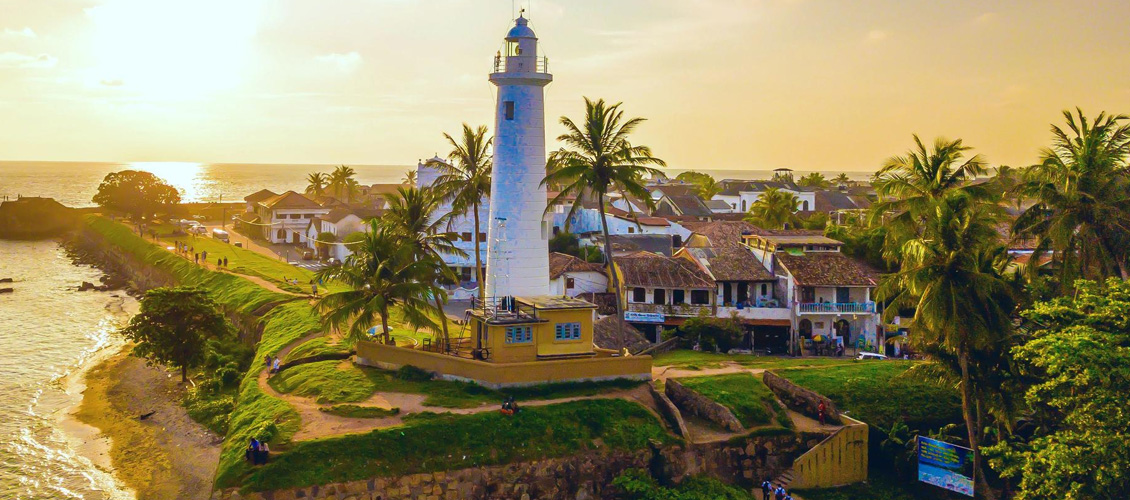Welcome to our site
Welcome to our site

The Southern Province of Sri Lanka is one of the nine provinces of Sri Lanka, the first level administrative
division of the country. The province is bordered by Sabaragamuwa Province and Uva Province to the North,
Eastern Province to the Northeast, Western Province to the Northwest and the Indian Ocean to the South, West
and East. The Province's capital is Galle. The Southern Province is a geographic area consisting of the
districts of Galle, Matara and Hambantota. Subsistence farming and fishing is the main source of income for
the vast majority of the people of this region. Important landmarks of the Southern Province include the
wildlife sanctuaries of the Yala and Udawalawe National Parks. Ussangoda in Ambalantota is a panoramic view of
the beach and the sea, and the holy city of Kataragama, and the ancient cities of Tissamaharama, Kirinda and
Galle.
Galle Fort. Galle Fort, in the Bay of Galle on the southwest coast of Sri Lanka, was built first in 1588 by
the Portuguese, then extensively fortified by the Dutch during the 17th century from 1649 onwards.
Veherahena Temple. Well-known temple on three acres featuring a huge statue of Buddha & tunnels filled with
paintings.
Matara Bodiya. Matara Bodhiya is a sacred fig tree in Matara, Sri Lanka. Its origin can be traced back to a
tragic story centred on King Kumara Dharmasena or Kumaradhatusena son of King Kasyapa of Sigiriya (512-522 AD)
and his closet friend, Kalidasa, a famous dramatist and poet.
Galle, formerly Point de Galle, port and city, Sri Lanka, situated on a large harbour on the island’s
southern coast.
Galle is the provincial capital and largest city of Southern Province, Sri Lanka and is the capital of Galle
District. Important natural geographical features in Galle include Rumassala in Unawatuna, a large mound-like
hill that forms the eastern protective barrier to Galle Harbour. Local tradition associates this hill with
some events of Ramayana, one of the great Hindu epics. The major river in the area is the Gin River (Gin
Ganga), which begins from Gongala Kanda, passes villages such as Neluwa, Nagoda, Baddegama, Thelikada and
Wakwella, and reaches the sea at Ginthota. The river is bridged at Wakwella by the Wakwella Bridge.
A UNESCO World Heritage site, Galle Fort displays awe-inspiring colonial relics vis-à-vis tropical trees, a
sprawling beach, and chic cafés. When visiting Galle Fort, definitely don’t miss the Galle Lighthouse — the
very icon of the Fort which has stood since 1848. Further, enjoy a stroll across the snazzy neighborhood:
Historical sites and museums, picturesque restaurants, and charming locals await your visit!
Matara is a major city in Sri Lanka, on the southern coast of Southern Province. It is the second largest
city in Southern Province. It is 160 km (99 mi) from Colombo. It is a major commercial hub, and it is the
administrative capital and largest city of Matara District
Matara is a busy, booming and sprawling commercial town that owes almost nothing to tourism – which can make
it a fascinating window on modern Sri Lankan life. Matara's main attractions are its ramparts, Dutch
architecture, a well-preserved fort and its street life.
Parey Dewa (Rock in Water) or Paravi Dupatha temple is a relatively modern Buddhist temple on Pigeon Island (a
small offshore island) in front of the city.
The temple is set in attractive gardens and houses numerous statues of Buddha and a replica of the alleged
footprint found on Adam's Peak.
Weragampita Rajamaha Viharaya Temple
Matara Bodhiya, a Buddhist temple, which is the site of a sacred fig tree.
Matara fort/ramparts: The Matara fort was built in 1560 by the Portuguese and was substantially re-built by
the Dutch in 1640, following the capture of Galle. The fort, which consists of a large stone rampart, occupies
the promontory, which separates the Niwala River lagoon and the ocean.
Dutch Reformed Church, Matara was constructed within Matara fort by the Dutch in 1706. It was extensively
remodeled in 1767, following the recapture of the fort in 1762.
Star Fort is on the western or landward side of the Nawali River. The fort was constructed by the Dutch
following the Matara rebellion in 1761, to protect the main fort from attacks originating from the river.
Construction of the unique star-shaped fort was completed in 1765.
Old Nupe Market was constructed in 1784 by the Dutch, about 3.2 kilometres (2.0 mi) from Matara fort.
St Mary's Church is on Beach Road. The date on the doorway (1769) refers to the reconstruction following the
1762 Matara Rebellion.
Hambantota
Ambalangoda
Hikkaduwa
Tangalle
Weligama

We are a multi-disciplinary team working together to create awesome websites that provide you with all you need to know about the countries of the Indian Ocean
Office No.2 14,Avenue sodnac
Quatre-Bornes
Copyright © 2022 MYP Online Marketing. All Rights Reserved. Conceptualised by MYP Online Marketing